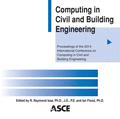The Development of a Framework for a Design for Safety BIM Tool
Publication: Computing in Civil and Building Engineering (2014)
Abstract
The character of building design offices has changed dramatically following the widespread adoption of digital design, drawing and modelling. Simultaneously, there is a growing recognition that designers have a responsibility to produce designs with minimal hazards to constructors and operators of facilities. By revisiting the philosophy of engineering, science and design, the radical impact the digital world has upon the traditional working practices of consulting engineering is explored. Consideration is given to the consequences of these changes upon the training, knowledge acquisition and effectiveness of engineers to deliver hazard-free designs. Historically, engineers used approximations and rules of thumb to produce acceptable, if not optimum, designs. Hand calculations undertaken by engineers accorded them the ability to develop a `feel' for the structure allowing `rogue' results to be challenged and corrected. Digital designs are produced so rapidly that the ability to gain experience can be severely impacted, contributing to a blind acceptance of results. Combined with isolated working, minimal scope for collaboration exists, leading to a sense of omniscience. The potential reduction in experiences of engineers raises questions about their ability to understand digital images and the ability to discern the pertinent issues. This paper outlines work being undertaken which could potentially help in the development of digital design systems - including Building Information Modelling (BIM) tools - that could educate and disseminate design for safety (DfS) knowledge, both tacit and codified, which is currently in danger of being lost.
Get full access to this article
View all available purchase options and get full access to this chapter.
Information & Authors
Information
Published In
Copyright
© 2014 American Society of Civil Engineers.
History
Published online: Jun 17, 2014
Authors
Metrics & Citations
Metrics
Citations
Download citation
If you have the appropriate software installed, you can download article citation data to the citation manager of your choice. Simply select your manager software from the list below and click Download.
